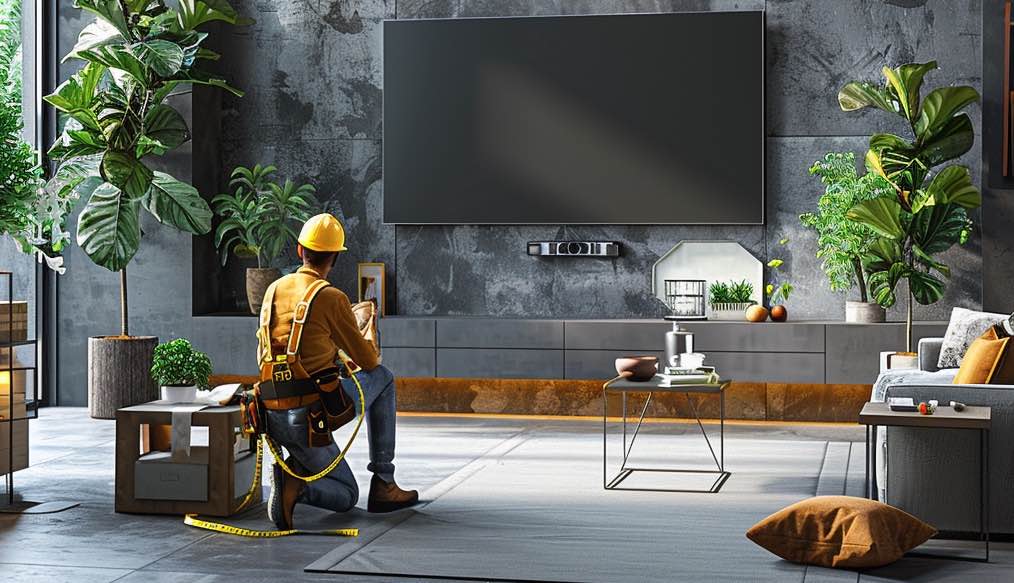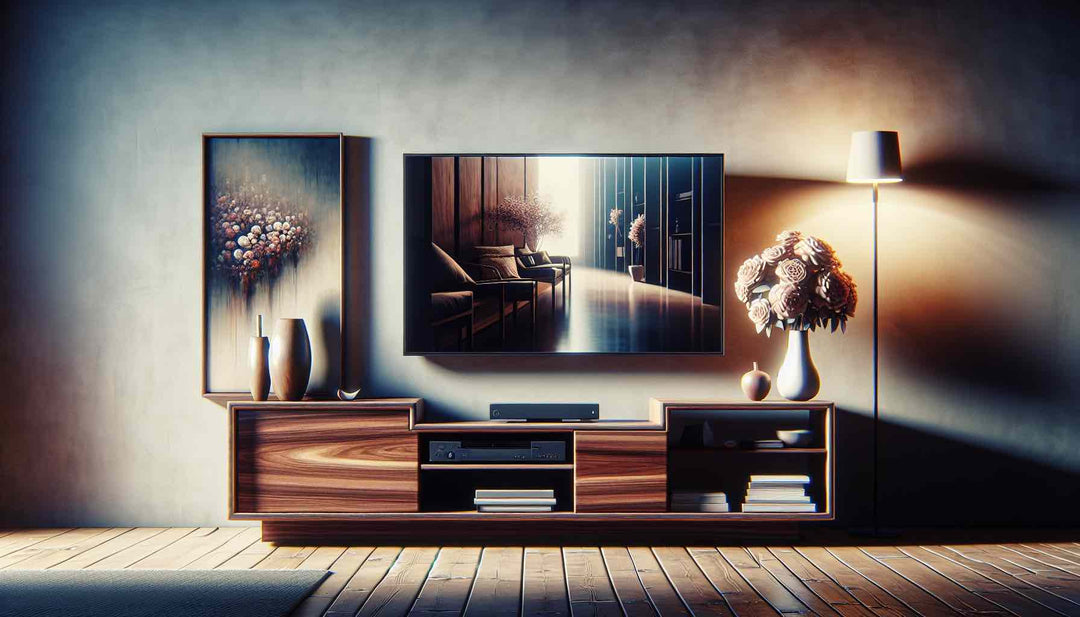Optimal TV Mounting Height: How High Should a TV Be Mounted?

The question ‘how high should a TV be mounted’ is common when setting up your home entertainment. The answer isn’t one-size-fits-all, but a good rule of thumb is to have the center of your TV about 42 inches (~1 meter) from the floor. This setup usually aligns with average eye level, maximizing comfort and enjoying viewing. Read on to learn more about optimizing your TV’s height based on room factors, TV size, and personal habits.
Key Takeaways
- Mount your TV with the screen's center at or slightly above eye level. This prevents neck strain and promotes better posture.
- TV size particularly impacts mounting height. For example, a 60-inch TV's center should be about 30 inches from the floor.
- Consider the furniture arrangement, room size, and your viewing habits. Use these factors to find the best TV height.
Determining the Ideal TV Mounting Height

Correctly determining the height for your TV mount is key to a pleasant viewing experience. Imagine setting up your flat screen TV only to realize you’ve got a crick in your neck after an hour of watching. Not fun, right? Mounting your TV at the right height can prevent this discomfort. It will make your viewing sessions much more enjoyable. The right TV height improves comfort. It also makes viewing immersive and engaging.
The general guideline for TV mounting height suggests positioning the screen’s center at or slightly above eye level. This setup keeps the screen in your natural line of sight. It reduces the need for head movement and promotes good posture. Under most circumstances, the ideal height for mounting a TV is about 42 inches from the floor to the center of the screen. But there’s more to consider, especially when we talk about different TV sizes and how they play into the overall setup.
Eye Level and Viewing Comfort
A critical consideration when deciding the TV mounting height is ensuring the screen’s center aligns with the viewer’s eye level. This alignment minimizes the need for head movement and keeps the screen within the natural line of sight. When the TV is at eye level, it not only reduces neck strain but also promotes better posture. Imagine sitting back in your favorite chair. Your eyes are perfectly aligned with your TV screen. You don't have to prop your head up or angle it down. That's the comfort we're aiming for.
It is important to position the TV such that the screen’s center aligns with or slightly below the main seating area’s eye level. Keep the TV at eye level. This ensures that everyone, no matter their height, enjoys a comfortable view. This setup is especially helpful in families. In these families, people of different heights watch the TV together. It’s all about finding that sweet spot that offers the most comfortable viewing height for everyone in the room.
Average Mounting Heights for Different TV Sizes
The size of the TV significantly impacts the determination of the ideal mounting height. For instance, a 60-inch TV should ideally have its center around 30 inches from the floor. Similarly, a 75-inch TV is typically mounted with the center around 37.5 inches from the floor. These measurements ensure the screen stays at a comfortable viewing height. They reduce strain and improve the viewing experience.
For a 65-inch TV, the center should be 32.5 to 35 inches from the floor. Some guidelines suggest mounting it at 40 inches. On the other hand, a 55-inch TV should be mounted around 61 inches from the floor to the center of the TV screen. These guidelines fit most common TV sizes. They ensure that, no matter your TV’s size, it is mounted at the best height for viewing.
Factors Influencing TV Mounting Height
The general TV mounting height guidelines are a great start. But, several factors can affect the best height for your setup. Spatial aspects, like enough clearance and good viewing angles, greatly affect the best TV mounting height. Also, practical factors matter. These include ease of access to outlets and storage for components. They can also affect the best TV mounting height. It’s not just about how high to mount your TV but also how it fits into your space and lifestyle.
Other factors to consider when determining the optimal TV mounting height include:
- The size of the TV
- The height and arrangement of your furniture
- The dimensions of your room
- Personal viewing habits
Larger TVs might need to be higher to fit the room's proportions. Your furniture and seating posture can also affect the height. Also, the viewer’s habits matter. This includes their typical TV-watching position (sitting or lying down). These habits can greatly affect the best TV height.
Let’s dive into these factors in more detail.
TV Size and Screen Height
The optimal height for mounting your TV largely depends on its size. This is an important factor to consider when setting up your home entertainment system. Larger screens may need to be mounted higher to fit proportionally within the room and to create a balanced view. Wider TVs are generally mounted higher than narrower ones, making the screen height appropriate for comfortable viewing.
This setup helps maintain a good viewing angle and prevents the TV from dominating the room or appearing out of place.
Furniture Arrangement
The height and layout of your furniture can greatly affect the ideal height for mounting your TV. For example, the height of seating options like sofas or bar stools can affect how high the TV should be mounted. This ensures a comfortable viewing experience. Typically, TVs mounted over furniture are positioned around 40 inches from the floor to the center of the screen.
The arrangement of furniture, including the distance from the TV, also plays a role in determining the best height for mounting.
Room Dimensions and Viewing Distance
The size of the room and the viewing distance from the TV can impact the optimal height for mounting. For example, if the room is wider, the TV might need to be mounted higher to ensure everyone has a good view. Additionally, rooms with higher ceilings may require the TV to be mounted at a lower height to maintain a comfortable viewing angle.
The optimal viewing distance should be considered, typically around 1.5 to 3 times the diagonal screen size. We highly recommend you reading further on how to measure your space for a TV stand and also using viewing distance calculator.
Viewer Preferences and Habits
Viewers' preferences and habits may require adjustments. These may change the TV mounting beyond standard guidelines. For example, tall people might prefer the TV higher. Short people might need it lower. Similarly, a person’s preferred viewing position, such as lying down or sitting upright, plays a role in determining the TV mounting height.
Personal preferences ensure that the mounted tv is at the perfect height for maximum comfort and enjoyment.
Calculating the Perfect Height for Your TV

Determining the ideal height for your TV requires a few simple steps. Here’s how to do it:
- Consider the viewer’s eye level when seated.
- The ideal height for the center of the TV should align with the viewer’s eye level, ensuring a comfortable viewing experience.
- Finding each person's eye level at home involves finding the midpoint between their highest and lowest eye marks.
- Use this height as a basis for measurements.
Next, consider the viewing distance from the seating area to the TV screen. The viewing distance should typically be 1.5 to 3 times the diagonal of the screen. If the TV is further away than 1.5 to 3 times the diagonal size of the screen, raise the mounting height between half and one inch for every 12 inches. This ensures that the TV remains at a comfortable viewing angle, reducing the risk of eye and neck strain.
Measuring Eye Level from Seating Position
Begin by sitting in your preferred viewing position to measure the eye level from the seating position. Use a tape measure to measure the distance from the floor to your eyes. This measurement will help find the best height for mounting the TV. It ensures the TV aligns with your eye level. That way, you will have a comfortable view.
Finding the Center Point of the TV
Identifying the TV’s center point is essential for precise mounting. Start by measuring the total height of the TV from the bottom edge to the top edge. Divide this measurement by two to find the center point of the TV.
This TV center point will guide you in aligning the TV correctly. It shows the optimal height for viewing. This ensures balanced and comfortable angles.
Adjusting for Viewing Distance
Modify the TV’s mounting height according to the tv viewing distance for a comfortable viewing experience. The optimal viewing distance is typically calculated as 1.5 to 3 times the diagonal screen size. For instance, the optimal viewing distance for a 55-inch TV is approximately 100 inches.
If the TV is too far away, raise it slightly. This keeps the ideal angle for TV viewing.
Special Considerations for Different Rooms
Each room has distinct attributes that affect the TV mounting height. The height at which a TV is mounted can vary depending on the room’s primary function and seating arrangement. For example, in an entertainment room, the TV should be mounted at 40 inches from the floor to the center of the screen. This is to create an immersive viewing experience.
Also, mounting a TV above a fireplace requires special considerations. These keep the TV safe from heat and ensure a good viewing angle.
Living Room Setup
In the living room, the best TV mounting height is 40 to 42 inches from the floor to the center of the screen. This aligns with the average seating height for ideal eye-level viewing. However, if your living room has higher seating, like home bars or stools, you might need to raise the screen for comfortable viewing.
Don’t forget to consider sources of glare from windows or lighting when positioning the TV to ensure the best viewing experience.
Bedroom TV Mounting
Mounting a TV in the bedroom requires consideration of the bed height and typical viewing angles while lying down. In a bedroom, the ideal TV height is about 50 inches from the floor to the screen's center. This height works for the tall beds and common viewing angles while lying down. Angling the TV downward can also help provide a more comfortable viewing experience.
This setup ensures that whether you’re sitting up or lying down, you can enjoy your shows comfortably.
Mounting Above a Fireplace

Mounting a TV above a fireplace comes with unique challenges, primarily due to heat exposure and viewing angles. Before you mount your TV, check that the surface temperature above the fireplace does not exceed the TV’s recommended limits. Using a mounting system with tilting brackets can help you adjust the viewing angle and reduce neck strain.
Ensure that the mantle does not obstruct the bottom of the screen for an unobstructed view.
Choosing the Right TV Mount
Choosing the appropriate TV mount is vital in ensuring the best possible viewing experience. Before purchasing a wall mount kit, decide on the location where the TV will be mounted. Ensure the mount can handle your TV’s size and weight, which are specified on the mount’s box and website. Most TV mounts are compatible with traditional wood-stud framing and drywall.
You can choose from several types of mounts. They include fixed, tilting, full-motion, and adjustable mounts. Each type has different benefits.
Fixed Mounts
Fixed mounts are ideal if your TV viewing is typically done directly in front and does not require any angle adjustments. They offer a very low profile, keeping the TV close to the wall, which enhances the aesthetics of the room. However, these mounts do not provide any movement options, making them less suitable for rooms with varied viewing angles.
If you prefer a sleek, minimalist look, a fixed mount might be the ideal choice for you.
Tilting and Full-Motion Mounts
Tilting and full-motion mounts let you adjust the TV. You can adjust it to fit different viewing angles and heights. Tilting mounts are useful if you’ll view your TV from an angle. They let you angle the TV downward. This reduces glare and keeps a good viewing angle when seated.
Full-motion mounts combine tilt and extend functions, offering comprehensive flexibility in TV positioning. These mounts are ideal for rooms where you need to adjust the mount tv position frequently.
Adjustable Mounts
Adjustable mounts offer personalized TV positioning. They fit individual preferences and various viewing positions. Full-motion mounts allow the TV to move in any direction. They offer more placement options. They can be adjusted to improve viewing angles from different parts of the room.
These mounts are great for households. They are needed when multiple viewing positions are needed. They are versatile and practical.
Installation Tips for Mounting a TV
Mounting a TV is the easiest safety tip that can reduce the risk of dangerous tip-overs. This increases safety, especially in homes with children. However, it can be challenging if the wall lacks solid attachment points behind the drywall. Studs are the preferred mounting points because they can hold weights exceeding 100 pounds. If there are no studs, toggle bolts can be used, but their weight limit is about 100 pounds. Be aware, this is a generalization. The actual weight capacity can vary significantly depending on the specific type and size of toggle bolt, as well as the wall material.
Here are some tips to guide you through the installation process.
Locating Studs and Preparing the Wall
Use a stud finder suitable for your wall type (drywall or plaster) to locate studs and prepare the wall for a secure TV mount. If a stud finder is unavailable, a strong magnet can help locate screws or nails attached to the studs. Typically, studs are located every 16 inches on-center behind the drywall. While this is common, it's worth noting that some older homes or specific wall types might have different stud spacing (e.g., 24 inches on-center).
Mark the locations of studs with painter’s tape before drilling, and drill pilot holes into the center of each stud for secure mounting.
Attaching the Mounting Bracket
To ensure compatibility, follow these steps to mount your TV on the wall:
- Align the mounting bracket over the holes on the TV’s back before attaching it to the wall.
- Use a template or the mounting plate to mark the drill holes and ensure it’s level before drilling.
- For walls without studs, use toggle bolts to secure the mounting plate.
Following these steps ensures the bracket is securely attached and level.
Securing the TV and Final Adjustments
Attach the TV bracket to the wall-mounted plate to secure the TV to the mounting bracket. Always check for level positioning after tightening the mounting plate to avoid any shifts. Make any final adjustments to ensure the TV is positioned correctly for optimal viewing.
This step is crucial for stability and achieving the perfect viewing angle.
Summary
Finding the perfect TV mounting height is a blend of science and personal preference. Consider factors like eye level, room size, furniture layout, and viewing habits. You can make a cozy and immersive viewing experience. Remember, the ideal height aligns with the viewer’s eye level. This ensures minimal strain and maximum enjoyment.
You may mount your TV in the living room, bedroom, or above a fireplace. Follow these guidelines to get the best results. Choose the right mount type for your needs and follow the installation tips to ensure a secure and stable setup. Happy viewing!
Frequently Asked Questions
At what height should a 55 inch TV be mounted?
Mount your 55-inch TV at around 61 inches (1.5 meters) from the floor to the center of the TV screen for the best viewing experience.
How does TV size affect mounting height?
Mounting a larger TV higher can help it fit better in the room and ensure a comfortable viewing experience.
Should the TV mounting height be adjusted for different rooms?
Yes, the optimal mounting height for a TV should be adjusted based on factors like room layout, furniture height, and viewing habits. Different rooms may require different mounting heights for the best viewing experience.
What type of mount should I use for my TV?
You should consider your needs. Fixed mounts are good for direct viewing. Tilting mounts cut glare, and full-motion mounts offer the most flexibility. Choose the one that best suits your preferences.
How can I ensure my TV is securely mounted?
Use a stud finder to find studs. Use the right brackets. Follow the manufacturer's instructions to secure the TV. This will ensure your TV is securely mounted.
















